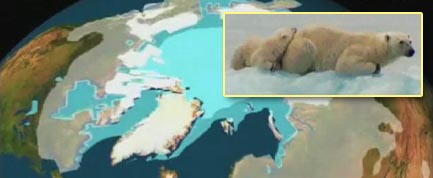North Pole Could be Ice-Free This Summer

Arctic sea ice could break apart completely at the North Pole this year, allowing ships to sail over the normally frozen top of the world.
The potential landmark thaw — the first time in human history the pole would be ice-free — is a stark sign of global warming, according to an article Friday on the web site of the The Independent, a London newspaper.
"Symbolically it is hugely important," said Mark Serreze of the U.S. National Snow and Ice Data Center in Colorado. "There is supposed to be ice at the North Pole, not open water."
Last year, the fabled Northwest Passage opened as Arctic ice retreated more than ever before.
There is no land at the North Pole, but as long as anyone has looked, it has remained a giant block of ice year-round. Scientists have been watching Arctic sea ice melt more and more each year. But each summer in recent years, the amount of ice has gotten thinner and thinner. Each winter's freeze, therefore, results in a thinner pack that, this summer, could melt altogether.
"The issue is that, for the first time that I am aware of, the North Pole is covered with extensive first-year ice," Serreze is quoted by The Independent. "I'd say it's even-odds whether the North Pole melts out."
Russia and other countries, meanwhile, have been arguing over who has rights to the region's resources, including potential oil reserves.
Get the world’s most fascinating discoveries delivered straight to your inbox.
Several studies in recent years have predicted that the North Pole could be ice-free within a few decades. Alarm has ratcheted up every summer as the ice gets thinner and thinner. In a study released June 10, scientist said the rapid meltoff in the Arctic could threaten permafrost in continental soil elsewhere above the Arctic circle in a warm version of the snowball effect.
Last summer saw a record melt of Arctic sea ice, which shrank to more than 30 percent below its average. Around the peak of the melt, in September, air temperatures over land in the western Arctic from August to October were more than 4 degrees Fahrenheit (2 degrees Celsius) above the 1978-2006 average.
"The rapid loss of sea ice can trigger widespread changes that would be felt across the region," said Andrew Slater, also of the National Snow and Ice Data Center.
- Video: Melting Sea Ice Seen From Orbit
- Top 10 Surprising Results of Global Warming
- North vs. South Poles: 10 Wild Differences
Robert is an independent health and science journalist and writer based in Phoenix, Arizona. He is a former editor-in-chief of Live Science with over 20 years of experience as a reporter and editor. He has worked on websites such as Space.com and Tom's Guide, and is a contributor on Medium, covering how we age and how to optimize the mind and body through time. He has a journalism degree from Humboldt State University in California.
 Live Science Plus
Live Science Plus






